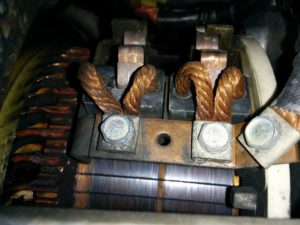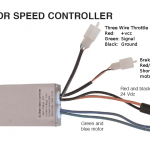After my high voltage fuse blew, I used a light bulb to make sure that the controller was not shorted and appeared to work (controlling 60 watts). [As it turns out, some of the MOSFETs in the controller had failed, but it would still work for low current draws; Where low is defined as 100A or less…more about that later…]
I thought that perhaps the motor was shorted out, as the motor resistance was only measuring 0.2 ohm, but it turns out that series wound DC motors do have low resistance, so this didn’t necessarily indicate a short circuit in the motor.
I replaced the expensive HV fuse with an inexpensive sacrificial fuse (18 ga lamp wire), then put the transmission in neutral and tried to spin the motor under no load. (I should have tried to turn the motor by hand, or by pushing the truck in gear just to see if it was free, but I didn’t think of that at the side of the road.)
I had a fire extinguisher and open water bottle standing by when I tried to spin the motor with no load, but all that happened is that my 18 ga wire flashed and disappeared with some smoking insulation. It is likely that I just needed a larger wire to handle the startup current (I was hoping that the capacitors in the controller would help out with this), or it may be that more MOSFETS’s in my controller died at this point.
So I gave up on the idea of driving the truck home with a replacement fuse, and we towed it home and I got started checking the motor over to try and see if it was pulling excessive current and was responsible for the blown fuse.
Here is a list of the items I checked, in the order I found them convenient to do :
- Could I turn the motor or was it physically seized up? I was able to roll the truck backwards while the transmission was in gear, so the motor could physically turn.
- I also turned the motor by hand (using the front shaft) with the transmission in neutral to make sure it was easy to turn and didn’t have any rough spots.
- I connected a multimeter to the motor terminals as I turned it by hand to see if the resistance goes up or down as you turn it (looking for a big spike down to indicate a short). On my motor, the lowest resistance was 0.2 ohm, and the highest was 0.5 ohms. (While actually in motion I would get a negative ohm rating as the motor generated a small amount of current/voltage, so I had to stop every 5-10 degrees and let the reading settle.)
- I checked the resistance from the + and – motor leads to the case of the motor (without disconnecting the cables on all the terminals) to check to see if there was a short. (They were both out of range, no connection on my meter.)
- I had been advised to disconnect the cable to all four of the motor terminals and check the resistance from each of the four terminals to the case, but since my motor +/- cables are connected in series with the other terminals I figure that if any of the terminals were shorted it would show up with the +/- resistance to case check. (I’ve been told that the measurements should be in the mega-ohm range when the motor is new, and may creep down as low as the 30 kOhm range after brush dust builds up. If it gets this low the motor needs cleaning with a motor cleaning solution you can buy at a motor shop.)
- Checked the insulation on the motor cables to make sure that it had not frayed and shorted to the chassis of the truck or motor.
- Visually inspect the brushes and commutator while turning. They had some wear, but looked to be working fine.

- Finally, I tried powering the motor (while disconnected from the driveshaft!) from a 12 volt auto battery (needs a lot of amps to get started) with some jumper cables. (Connect to the battery terminal last so the spark does not hurt the threads on the motor terminals.)
At this point, my motor spun just fine, had no visible arcing or unusual noises or rattles, so I decided that the motor itself was fine, and my fuse failure was due to something else. My thinking at the time was that it was simply age and vibration, combined with the extra amps that my new lithium ion battery pack can provide. So I decided to put everything back together and take it for a test drive with a new fuse. [More on how that turned out below.]
FYI – The Curtis controller current limits at 500 amps, but my old lead acid golf cart battery pack would typically never provide more than 300 amps, while the Nissan Leaf Lithium battery pack is happy to provide more than the full 500 amps.)
If the motor spin test hadn’t worked, here are a few more steps that I would have performed to try and isolate what was wrong with the motor.
- Pull all of the brushes out so they don’t contact the commentator, then re-test the resistance from the motor terminals to the housing. If it reads no connection, the field windings are OK (not shorted). If you get a reading here, it indicates which field winding is shorted to the case (possibly just by dust…)
- Insert each brush back into it’s holder one by one (only one inserted at a time) and check the resistance of that brush to the motor housing (should be no connection).
However, the motor appeared to be good, my controller had tested good with a 60 watt light bulb, so, on to the road test!
How I blew up (the rest of) my Curtis 1231c-8601 controller:
Having verified that my motor spun just fine on 12 volts, and that my controller could control a 60 watt light bulb with no problems, I figured that perhaps my 10+ year old fuse had just blown due to old age. So I replaced the fuse, and used the controller to spin the motor in neutral, which worked just as well as the 12 volt battery.
So I decided to go on a test drive, and pulled the truck out of the driveway. It drove normally at slow (< 15 mph) speeds, but when I tried to accelerate to 30 mph I got some shuttering and pulsing that I would normally associate with the controller going into current limiting mode, and the truck had no real acceleration to speak of. At this point I probably should have realized that the controller was half gone and aborted the test, but instead I decided to try and see if the truck could reach the speed limit, and after another thirty seconds of driving I lost power to the motor completely. (But my HV fuse had not blown.)
I figure that the controller had been limping along on a fraction of it’s original MOSFETs, and by driving it again I blew the remainder of them out. So, I have ordered a replacement (used) motor controller, and am hoping that it will get me back on the road relatively quickly.




Pingback: Diagnosing a blown high voltage fuse: S-10 EV | Jay's Technical Talk
Hi.
I have the same motor and it has failed. I have a connection from motor terminals to body and it hunts when powered like it is running on one field.